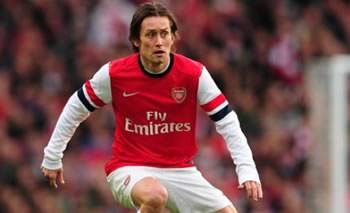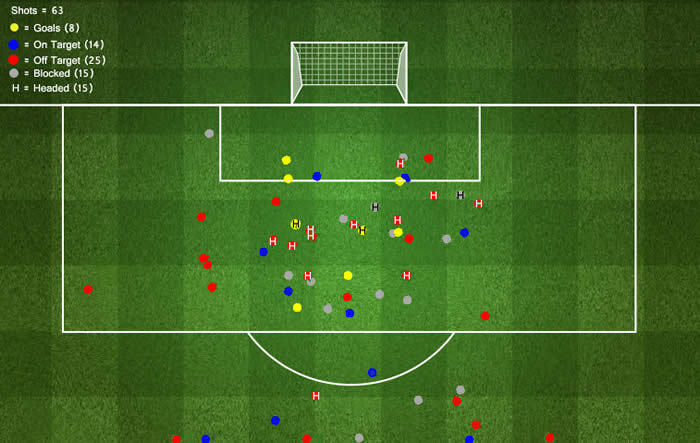Aaron Ramsey
No one can say at Arsenal that players are pigeon-holed, but in a sense for Aaron Ramsey, that might have been the case. When he joined Arsenal in 2008, tiki-taka, following Spain’s triumph in the European Championships and then subsequently Barcelona’s domination, was in vogue at the time. Arsenal too, were going through a transitional phase and players comfortable in possession would become a key factor of their game: Cesc Fabregas would be symbolic of that. Youngsters coming in would continue that tradition and as such, Ramsey’s progression to a play-making, pass-master midfielder was obvious. Except over time, Arsene Wenger realised that Ramsey need not be a master of anything, but simply good at all things.
Actually, when Wenger signed Aaron Ramsey, he described the Welshman as an “offensive Roy Keane”, indicating he wasn’t putting any limit on the player Ramsey could be. Playing Ramsey out wide was to help him achieve his potential as Wenger says, by deploying a central player wide, it allows him to “get used to using the ball in a small space, as the touchline effectively divides the space that’s available to him by two; when you move the same player back to the middle, he breathes more easily and can exploit space better.”
Ramsey has never looked back and since the start of 2013, he has progressed into an accomplished number 8, winning possession, finding team-mates and a game based on non-stop running. The next step will surely be to become the complete midfielder – and that means also becoming a master of the pass in the process.
Of course, Ramsey’s evolution follows the trend in football where players need to be all-rounders, no more so than in midfield – the heart of any given team. Manchester City play with two central midfielders who can’t really be described as holding midfielders or playmakers. Even across the border, Tottenham Hotspur’s muddled attempt at playing progressive football has seen them discard the destroyers.
In Arsenal’s midfield, there’s also Mikel Arteta who has had to adapt his game and learn how to steal the ball off opponents. Indeed, that’s one part of Ramsey’s evolution – more than his goalscoring – that has impressed me most: his tackling. He’s one of the highest rated midfielders in the Premier League at regaining possession back. This after Sam Allardyce says that teams nowadays “train players to intercept rather than tackle – because most tackles are fouls now”. Ramsey is really becoming a master at everything.
Pressing and possession
A big feature of Arsenal this season has been “winning ugly”. That means to find a compromise in matches where they’re under the cosh between their normal swashbuckling style and concerted defensive discipline. That’s what Arsenal have done this season, more willing to sit back and soak pressure, and more able to hold an opponent at arm’s length, and to break up play when it needs to be done. They have scored 21 goals after 60 minutes, often scoring to take the game away from the opponents, but they have also won 17 points after this period, indicating how well they manage moments.
 Likewise, Arsenal have eschewed possession somewhat this season, dropping from the most ball-hungry side in the league for the last three years, to the fourth this season, with an average of 56.2% possession per game. Similarly, they lie in seventh for shots taken per game.
Likewise, Arsenal have eschewed possession somewhat this season, dropping from the most ball-hungry side in the league for the last three years, to the fourth this season, with an average of 56.2% possession per game. Similarly, they lie in seventh for shots taken per game.
Possession has lost its lustre a bit in the last year with Bayern Munich overtaking Barcelona as the dominant team in Europe. It’s still important but football is increasingly a team game. Of course, this isn’t a revolutionary statement to make; football has always been about the collective but think about Real Madrid’s fixation with individuals in the mid-to-early 2000s and its noticeable that there’s been a slight shift. Players have to be all-rounders now to fit into the overall philosophy of the coach, contributing to both spheres of attack and defence. They can now run more, are taller and faster so it makes sense that emphasis has been placed more on universality; on a game where teams move together up and down, left and right on the pitch. That’s the same for Arsenal: fluency in possession is still crucial, but shape might have usurped that now.
Wide players
The unfortunate injury to Theo Walcott – arguably the one player that gives “depth” to Arsenal’s team – means Arsenal might revert back to a “wingerless” system, although the returns of Lukas Podolski and Alex Oxlade-Chamberlain can soften the blow of the loss. It’s an interesting system Arsenal used without Walcott earlier this season. Normally, you think of selecting players by their positions on the pitch – one striker, two wingers, an attacking midfield etc. With Arsenal, it’s about how they can manipulate space better. Usually that means playing a creative midfield on one flank, to allow Arsenal to keep the ball better, and one winger on the other side who stretches play.
Arsenal know as well, that they’ll often face teams that defend with two holding midfielders so what they’ll do is ask one of the wide players, or both as it has been at various points this season, to come off the flanks and create an overload in the middle. That creates space, of course, for the full-backs to push forward, but it also gives space to that wide player – who initially might have been suffocated on the flanks – in the hole in between the opposing full-back and just to the side of one of the two holders in a 4-2-3-1. That’s what Arsenal frequently try to do; get into that space (sometimes called the half-space or the quarter-space) because they know it is hard to cover. Why? Because the opposing winger will never track that far, while the full-back knows that if he tucks in too narrow, it distorts the shape of the team. The onus then, is on one of the holders to squeeze the space but of course, by trying to engage one of those creative wingers of Arsenal’s, say Santi Cazorla, he runs the risk of leaving the middle open.
It’s hard to explain but it’s an opportunity area for Arsenal to exploit, a gap where good players often take advantage of (think about it as the hole in the Death Star; imperceptible at first but a weakness nevertheless). One team who frequently expose this space is Pep Guardiola’s Bayern Munich who instead of asking the creative wingers to narrow, they move wider and open that space for the full-backs or another midfield to run into and occupy. With Arsenal’s attacking game all about dragging opponents about, watch closely and see how many goals they create this way. Lukas Podolski is particularly adept at this, drifting inside and playing one-twos before bursting behind the marker to play a cut-back or get onto one himself.
Koscielny/Mertesacker
It seems everybody has been waiting for Mertescielny to fail. Whenever Arsenal faces one of the big teams, obituaries are prepared in advance for the partnership. Except each time, they come on top. The one time the pair did fail, however, came against Manchester City when Laurent Koscielny had to go off injured late in the first-half with the result still in the balance. But in that game, a 6-3 defeat, the protection was painfully poor from the midfield as Arsenal were overpowered. But against some of the other top strikers – Suarez and Sturridge, Lewandowski, Lukaku – Koscielny and Mertesacker have mainly come out on top.
Their partnership follows what has become a trend whenever teams play a back four: one of the centre-backs attack and the other covers. Against two strikers, the duo has shown how much their relationship has prospered because against such a set-up, both defenders have to mark (as opposed to playing against a lone-striker where Mertesacker will normally attack the ball and Koscielny drops back). When Vermaelen came in against Manchester United (a 1-0 defeat but a good defensive performance) and in the FA Cup against Tottenham, the dynamism of the system remained the same: one attacks, one covers. Again, these were matches where the opponents deployed two strikers. With both centre-backs generally marking, the role of Arteta thus becomes more important and in those games he played closer to them so they wouldn’t get outnumbered. It’s not just the two centre-backs then; with Arteta, Arsenal have a formidable defensive triangle.
Olivier Giroud
A little to the annoyance of some fans, Arsene Wenger’s persistence with Olivier Giroud as the only striker, might not be much more than he feels safer with the 6’4 striker in the side. In a team of miniscule ball-players, Giroud offers an out-ball, a relief, whenever they’re in trouble. He is also a reliable figure at set-pieces, as Wenger trusts him with one of the middle positions in Arsenal’s zonal-marking system. Wenger: “Every time I think I give him a rest but we have a team that is a bit short, lightweight and more focused on mobility and technical movement so he is the one guy who has that strength and structure for us. That fighting up front is very important for us.”
In that sense, Giroud’s a bit of a throwback striker – a target-man – but there is also greater subtlety to his play that makes him indispensable to Arsenal. His deft touches, neat flicks and muscular hold-up brings others into play, in a way gluing Arsenal’s passing game together, and that’s what endears him so much to Wenger. He runs a lot too, further getting on the manager’s good-books.
Finding a place for Giroud alongside some of the top strikers in Europe is a difficult one. In the age of the super-striker – Falcao, Cavani, Ibrahimovic, van Persie, Messi, Ronaldo etc…. – where 40+ goals in a season are standard, Giroud’s goalscoring record is painfully low. He has, though, some of the altruistic qualities those players have and strikers nowadays must have, more than just scoring goals, they must be creators too. That’s what Giroud does, as typified by his eye of the needle assist to Jack Wilshere against Norwich City.
But, we’ll see if he can remain Arsene’s indisputable first-choice striker: I tend to see Giroud’s role in the side, despite his qualities, as a bit of a buffer – a stop-gap even. That means he’s first-choice mainly because he makes Arsenal play – “physical presence, technique and charisma”,Giroud is the “type of striker who is difficult to find nowadays”, Wenger says – it means it carries little risk for a team that is still adapting to each other, still working out each others’ movements.
In that sense, Giroud then, acts as a bit of a buffer, lessening the impact of this adjustment period by taking hits for the team as they strive to find better balance and understanding. That’s why Wenger is willing to overlook some of his deficiencies – namely his goalscoring, which fans are understandably less forgiving of – because Giroud makes the team play. Which begs the question: When Arsenal becomes fully in tune with each other, perhaps then Wenger might be more willing to leave out Giroud than he is at the moment?



